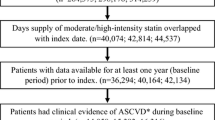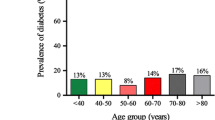Abstract
Introduction
Whereas some guidelines recommend statin use to achieve low-density lipoprotein cholesterol (LDL-C) goal < 70 mg/dL for primary prevention of atherosclerotic cardiovascular disease (ASCVD) in patients at higher risk, others recommend against a target LDL-C level. Achieving a target level < 70 mg/dL commonly requires the use of high intensity statins, which has been associated with higher risk of diabetes progression. The objective of this study is to assess the association of strict (≤ 70 mg/dL) versus lenient (> 70 to100 mg/dL) LDL-C lowering on major adverse cardiovascular events (MACE), diabetes progression, diabetes microvascular complications, and total mortality in patients with diabetes.
Methods
This was a retrospective propensity score (PS)-matched study from a national cohort of, predominantly male, veterans diagnosed with diabetes without prior cardiovascular disease (from fiscal years 2003–2015), who were initiated on a statin. We created PS to match strict (mean LDL-C during follow-up ≤ 70 mg/dL) versus lenient (mean LDL-C during follow up > 70–100 mg/dL) using 65 baseline characteristics including comorbidities, risk scores, medication classes usage, vital signs, and laboratory data. Outcomes included MACE, diabetes progression, microvascular diabetes complications, and total mortality.
Results
From 80,110 eligible patients, we PS-matched 21,294 pairs of statin initiators with strict or lenient LDL-C lowering. The mean (SD) age was 64 (9.5) years and mean (SD) duration of follow-up was 6 (3) years. MACE was similar in the PS-matched groups [6.1% in strict versus 5.8% in lenient; odds ratio (OR): 1.06; 95% confidence interval (95% CI) 0.98–1.15, P = 0.17]. Diabetes progression was higher among the strict vs lenient group (66.7% in strict versus 64.1% in lenient; OR 1.12; 95% CI 1.08–1.17, P < 0.001). There was no difference in microvascular diabetes complications (22.3% in strict versus 21.9% in lenient; OR 1.02; 95% CI 0.98–1.07, P = 0.31) and no difference in total mortality (14.6% in strict versus 15% in lenient; OR 0.97; 95% CI 0.92–1.02, P = 0.20).
Conclusion
Strict compared with lenient lowering of LDL-C with statins in men with diabetes without preexisting ASCVD did not decrease the risk of MACE but was associated with an increased diabetes progression. Clinicians should monitor their patients for diabetes progression upon escalating statins to achieve LDL-C levels ≤ 70 mg/dL.

Similar content being viewed by others
References
ElSayed NA, Aleppo G, Aroda VR, Bannuru RR, Brown FM, Bruemmer D, et al. 10. cardiovascular disease and risk management: standards of care in diabetes—2023. Diabetes Care. 2022;46(Supplement_1):S158–90.
Mach F, Baigent C, Catapano AL, Koskinas KC, Casula M, Badimon L, et al. 2019 ESC/EAS Guidelines for the management of dyslipidaemias: lipid modification to reduce cardiovascular risk. Eur Heart J. 2020;41(1):111–88.
Force USPST. Statin use for the primary prevention of cardiovascular disease in adults: US Preventive Services Task Force Recommendation Statement. JAMA. 2022;328(8):746–53.
O’Malley PG, Arnold MJ, Kelley C, Spacek L, Buelt A, Natarajan S, et al. Management of dyslipidemia for cardiovascular disease risk reduction: synopsis of the 2020 Updated U.S. Department of Veterans Affairs and U.S. Department of Defense Clinical Practice Guideline. Ann Internal Med. 2020;173(10):822–9.
Simic I, Reiner Z. Adverse effects of statins—myths and reality. Curr Pharm Des. 2015;21(9):1220–6.
Efficacy and safety of atorvastatin in the prevention of cardiovascular end points in subjects with type 2 diabetes. diabetes care. American Diabetes Association.
Mansi IA, Chansard M, Lingvay I, Zhang S, Halm EA, Alvarez CA. Association of statin therapy initiation with diabetes progression: a retrospective matched-cohort study. JAMA Internal Med. 2021;181(12):1562–74.
Lund JL, Richardson DB, Sturmer T. The active comparator, new user study design in pharmacoepidemiology: historical foundations and contemporary application. Curr Epidemiol Rep. 2015;2(4):221–8.
Danaei G, Rodriguez LA, Cantero OF, Logan R, Hernan MA. Observational data for comparative effectiveness research: an emulation of randomised trials of statins and primary prevention of coronary heart disease. Stat Methods Med Res. 2013;22(1):70–96.
Allison DB, Faith MS, Heo M, Townsend-Butterworth D, Williamson DF. Meta-analysis of the effect of excluding early deaths on the estimated relationship between body mass index and mortality. Obes Res. 1999;7(4):342–54.
Floyd JS, Blondon M, Moore KP, Boyko EJ, Smith NL. Validation of methods for assessing cardiovascular disease using electronic health data in a cohort of Veterans with diabetes. Pharmacoepidemiol Drug Saf. 2016;25(4):467–71.
Kivimaki M, Batty GD, Singh-Manoux A, Britton A, Brunner EJ, Shipley MJ. Validity of cardiovascular disease event ascertainment using linkage to UK hospital records. Epidemiology. 2017;28(5):735–9.
Henderson DC, Cagliero E, Copeland PM, Louie PM, Borba CP, Fan X, et al. Elevated hemoglobin A1c as a possible indicator of diabetes mellitus and diabetic ketoacidosis in schizophrenia patients receiving atypical antipsychotics. J Clin Psychiatry. 2007;68(4):533–41.
Trends in diabetes and diabetic complications, 1980–1987. Diabetes Care. American Diabetes Association.
Christakis DA, Feudtner C, Pihoker C, Connell FA. Continuity and quality of care for children with diabetes who are covered by medicaid. Ambul Pediatr. 2001;1(2):99–103.
Elixhauser A. Clinical Classifications Software (CCS) for ICD-9-CM. Databases and related tools from the Healthcare Cost and Utilization Project (HCUP).
Elixhauser A, Steiner C, Palmer L. Clinical Classifications Software (CCS) for ICD-9-CM. Databases and Related Tools from the Healthcare Cost and Utilization Project (HCUP) U.S. Agency for Healthcare Research and Quality; 2012. p. Appendix A.
General cardiovascular risk profile for use in primary care. Circulation.
Deyo RA, Cherkin DC, Ciol MA. Adapting a clinical comorbidity index for use with ICD-9-CM administrative databases. J Clin Epidemiol. 1992;45(6):613–9.
Becker S, Ichino A. Estimation of average treatment effects based on propensity scores. Stand Genomic Sci. 2002;2(4):358–77.
Leuven E, Sianesi B. PSMATCH2: Stata module to perform full Mahalanobis and propensity score matching, common support graphing, and covariate imbalance testing. http://ideas.repec.org/c/boc/bocode/s432001.html. version 4.0.5 ed; 2003.
Abbasi F, Lamendola C, Harris CS, Harris V, Tsai M-S, Tripathi P, et al. Statins are associated with increased insulin resistance and secretion. Arteriosclerosis Thromb Vasc Biol. 2021;41(11):2786–97.
Dormuth CR, Filion KB, Paterson JM, James MT, Teare GF, Raymond CB, et al. Higher potency statins and the risk of new diabetes: multicentre, observational study of administrative databases. BMJ. 2014;348:g3244.
Preiss D, Seshasai SRK, Welsh P, Murphy SA, Ho JE, Waters DD, et al. Risk of incident diabetes with intensive-dose compared with moderate-dose statin therapy: a meta-analysis. JAMA. 2011;305(24):2556–64.
Itoh H, Komuro I, Takeuchi M, Akasaka T, Daida H, Egashira Y, et al. Intensive treat-to-target statin therapy in high-risk Japanese patients with hypercholesterolemia and diabetic retinopathy: report of a randomized study. Diabetes Care. 2018;41(6):1275–84.
Leibowitz M, Karpati T, Cohen-Stavi CJ, Feldman BS, Hoshen M, Bitterman H, et al. Association between achieved low-density lipoprotein levels and major adverse cardiac events in patients with stable ischemic heart disease taking statin treatment. JAMA Internal Med. 2016;176(8):1105–13.
Kim JY, Choi J, Kim SG, Kim NH. Relative contributions of statin intensity, achieved low-density lipoprotein cholesterol level, and statin therapy duration to cardiovascular risk reduction in patients with type 2 diabetes: population based cohort study. Cardiovasc Diabetol. 2022;21(1):28.
Sacks FM, Hermans MP, Fioretto P, Valensi P, Davis T, Horton E, et al. Association between plasma triglycerides and high-density lipoprotein cholesterol and microvascular kidney disease and retinopathy in type 2 diabetes mellitus: a global case-control study in 13 countries. Circulation. 2014;129(9):999–1008.
2021 ESC Guidelines on cardiovascular disease prevention in clinical practice. European Heart Journal. Oxford Academic.
Buse JB, Ginsberg HN, Bakris GL, Clark NG, Costa F, Eckel R, et al. Primary prevention of cardiovascular diseases in people with diabetes mellitus: a scientific statement from the American Heart Association and the American Diabetes Association. Diabetes Care. 2007;30(1):162–72.
Goldberg RB, Stone NJ, Grundy SM. The 2018 AHA/ACC/AACVPR/AAPA/ABC/ACPM/ADA/AGS/APhA/ASPC/NLA/PCNA Guidelines on the Management of Blood Cholesterol in Diabetes. Diabetes Care. 2020;43(8):1673–8.
Eldor R, Raz I. American Diabetes Association indications for statins in diabetes: is there evidence? Diabetes Care. 2009;32(Suppl 2):S384–91.
Mansi I, Mortensen E. The controversy of a wider statin utilization: why? Expert Opinion in Drug Safety. 2013;12(3):327–37.
Blankstein R, Gupta A, Rana JS, Nasir K. The implication of coronary artery calcium testing for cardiovascular disease prevention and diabetes. Endocrinol Metab. 2017;32(1):47–57.
Proof That Lower Is Better—LDL Cholesterol and IMPROVE-IT. NEJM.
Author information
Authors and Affiliations
Corresponding author
Ethics declarations
Funding
No funding was provided for this work. Resources of the Orlando VA Medical Center were used to conduct the study.
Conflict of interest/Disclosure
The authors declare that they do not have a financial conflict of interest related to this work. CAA has received research funding from Merck, Boehringer Ingelheim, and Bristol Myers Squibb not related to this project. CAA us supported, in part, by the National Institutes of Health Clinical and Translational Science Award (UL1TR003163)
Ethics approval
This study was approved by the VA North Texas Health Care System (1589775-3), Orlando VA Health Care System (1679434-1), and the Texas Tech University Health Sciences Center (A14-3811).
Consent to participate
Institutional review boards have waived informed consent because the study used only previously collected, deidentified data.
Consent for publication
All authors have reviewed the manuscript and agree on its publication and submission to the Journal.
Data availability
Data are stored in the VA Informatics and Computing Infrastructure (VINCI), the operational platform for health services research at the Veterans Healthcare Administration (VHA). VINCI acts as data steward for VHA Data Systems. Data in VINCI cannot be copied, transferred, or printed. Access to data by other researchers is possible following VINCI protocols, as described in VINCI Central website: http://vaww.vinci.med.va.gov/VinciCentral.
Code availability
Codes used in this study is provided in the Electronic Supplementary Material.
Author contributions
Concept and study design: all authors; data collection and statistical analysis: CA and IM; results’ interpretation: all authors; initial draft of the manuscript: VO and OM; final review and edit of the manuscript: all authors. Dr. Mansi is the overall guarantor for data and study integrity.
Disclaimer
The views expressed herein are those of the authors and do not reflect the official policy or position of the Department of the Army, Department of Defense, VA Administration, or the US Government or any of its affiliated entities. This research was supported (in whole or in part) by the resources of the Orlando VA Medical Center. Some of the authors are employees of the US government. This work was prepared as part of their official duties and, as such, there is no copyright to be transferred. This research was supported (in whole or in part) by HCA Healthcare and/or an HCA Healthcare affiliated entity. The views expressed in this publication represent those of the author(s) and do not necessarily represent the official views of HCA Healthcare or any of its affiliated entities.
Supplementary Information
Below is the link to the electronic supplementary material.
Rights and permissions
About this article
Cite this article
Odeleye, V., Masarweh, O., Restrepo, J. et al. Association of Strict Versus Lenient Cholesterol Lowering with Cardiac Outcomes, Diabetes Progression and Complications, and Mortality in Patients with Diabetes Treated with Statins: Is Less More?. Drug Saf 46, 1105–1116 (2023). https://doi.org/10.1007/s40264-023-01347-8
Accepted:
Published:
Issue Date:
DOI: https://doi.org/10.1007/s40264-023-01347-8




